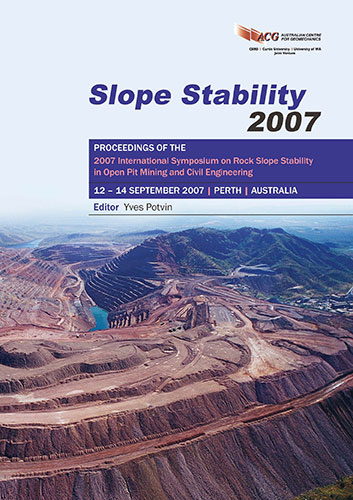Geotechnical Characterisation of Waste Material in Very High Dumps with Large Scale Triaxial Testing

|
Authors: Linero, S; Palma, C; Apablaza, R |
DOI https://doi.org/10.36487/ACG_repo/708_2
Cite As:
Linero, S, Palma, C & Apablaza, R 2007, 'Geotechnical Characterisation of Waste Material in Very High Dumps with Large Scale Triaxial Testing', in Y Potvin (ed.), Slope Stability 2007: Proceedings of the 2007 International Symposium on Rock Slope Stability in Open Pit Mining and Civil Engineering, Australian Centre for Geomechanics, Perth, pp. 59-75, https://doi.org/10.36487/ACG_repo/708_2
Abstract:
Large scale, open pit copper mining in Chile involves the mobilization of large amounts of waste material from the pit to areas specifically prepared to store this material. The challenge faced by some mines in the Andean mountain range is the lack of available space for waste dumps given the steepness of the typical mountainous topography. Because of this there is an ever more urgent need to design very high dumps that are unprecedented in the world. Usually verification of the stability of waste dumps does not pose a significant difficulty. However, in the case of deposits that can be hundreds of metres high at the face, such as those planned by Codelco´s Andina Division, it becomes necessary to have detailed knowledge of the geomechanical behaviour of the material. In general, the studies in characterisation of coarse granular material have been done in relation to the construction of rockfill dams. Waste dumps, as opposed to dams, are generally built simply by overturning truckloads, which produce a low initial density. Additionally, the particles of material can reach sizes in the order of metres, which is not common in dam construction. The investigation and results of the characterization of the geomechanical properties of the waste material from Codelco´s Andina Division is presented in this paper. In particular, characterisation of the particles and large scale shear resistance tests were carried out in an attempt to simulate the field conditions in terms of grain size distribution of the material and level of the expected loads.
References:
ASTM C 535-96 Standard Test Method for Resistance to Degradation of Large-Size Coarse Aggregate by Abrasion and
Impact in the Los Angeles Machine.
ASTM C 88-05 Standard Test Method for Soundness of Aggregates by Use of Sodium Sulfate or Magnesium Sulfate.
ASTM D 4767 Standard Test Method for Consolidated Undrained Triaxial Compression Test for Cohesive Soils.
Charles, J.A. and Watts, K.S. (1980) The influence of confining pressure on the shear strength of compacted rockfill.
Geotechnique 30, No. 4, pp. 353-367.
Duncan, J.M. and Chang, C-Y. (1970) Nonlinear analysis of stress and strain in soil, Journal of the Soil Mechanics and
Foundations Division. ASCE, pp. 1629-1653.
Indraratna, I., Wijewardena, L.S.S. and Balasubramaniam, A.S. (1993) Large-scale triaxial testing of Greywacke
rockfill, Geotechnique 43, No. 1, pp. 37-51.
Lee, Y. (1986) Strength and deformation characteristic of rockfill. PhD thesis, Asian Institute of Technology.
Leps, T. (1970) Review of shearing strength of rockfill. Journal of Soil Mechanics and Foundation Division, ASCE.
Vol. 96, SM4, pp. 1159-1170.
Marsal, R.J. (1980) Contribución a la mecánica de medios granulares. Comisión Nacional de Electricidad, Mexico, D.F.
Marsal, R.J. and Resendiz, D.R. (1975) Presas de Tierra y Enrocamiento. Mexico. Ed Limusa, pp. 237-239.
Verdugo, R., Gesche, S. and De La Hoz, K. (2003) Metodología de Evaluación de Parámetros de Resistencia al Corte
de Suelos Gruesos. XII Panamerican Conference on Soil Mechanics and Foundation Engineering, MIT. USA.
Vol. 1, pp. 691-696.
Rock Slope Design
Slope Stability 2007, Perth, Australia 75
© Copyright 2026, Australian Centre for Geomechanics (ACG), The University of Western Australia. All rights reserved.
View copyright/legal information
Please direct any queries or error reports to repository-acg@uwa.edu.au
View copyright/legal information
Please direct any queries or error reports to repository-acg@uwa.edu.au